Epidemiology: Lifestyle Interventions for Type 2 Diabetes Prevention
VerifiedAdded on 2023/01/23
|7
|1643
|71
AI Summary
This article discusses the effectiveness of lifestyle interventions in preventing type 2 diabetes. It examines the relationship between weight loss and diabetes risk reduction, as well as the consistency and coherence of previous studies. The study also considers the temporal association and dose-response relationship between lifestyle intervention and diabetes prevention. Confounding variables and chance variation are also discussed.
Contribute Materials
Your contribution can guide someone’s learning journey. Share your
documents today.

Running head: Epidemiology 1
Epidemiology
by
Course:
Tutor:
University:
Department:
Date:
Epidemiology
by
Course:
Tutor:
University:
Department:
Date:
Secure Best Marks with AI Grader
Need help grading? Try our AI Grader for instant feedback on your assignments.
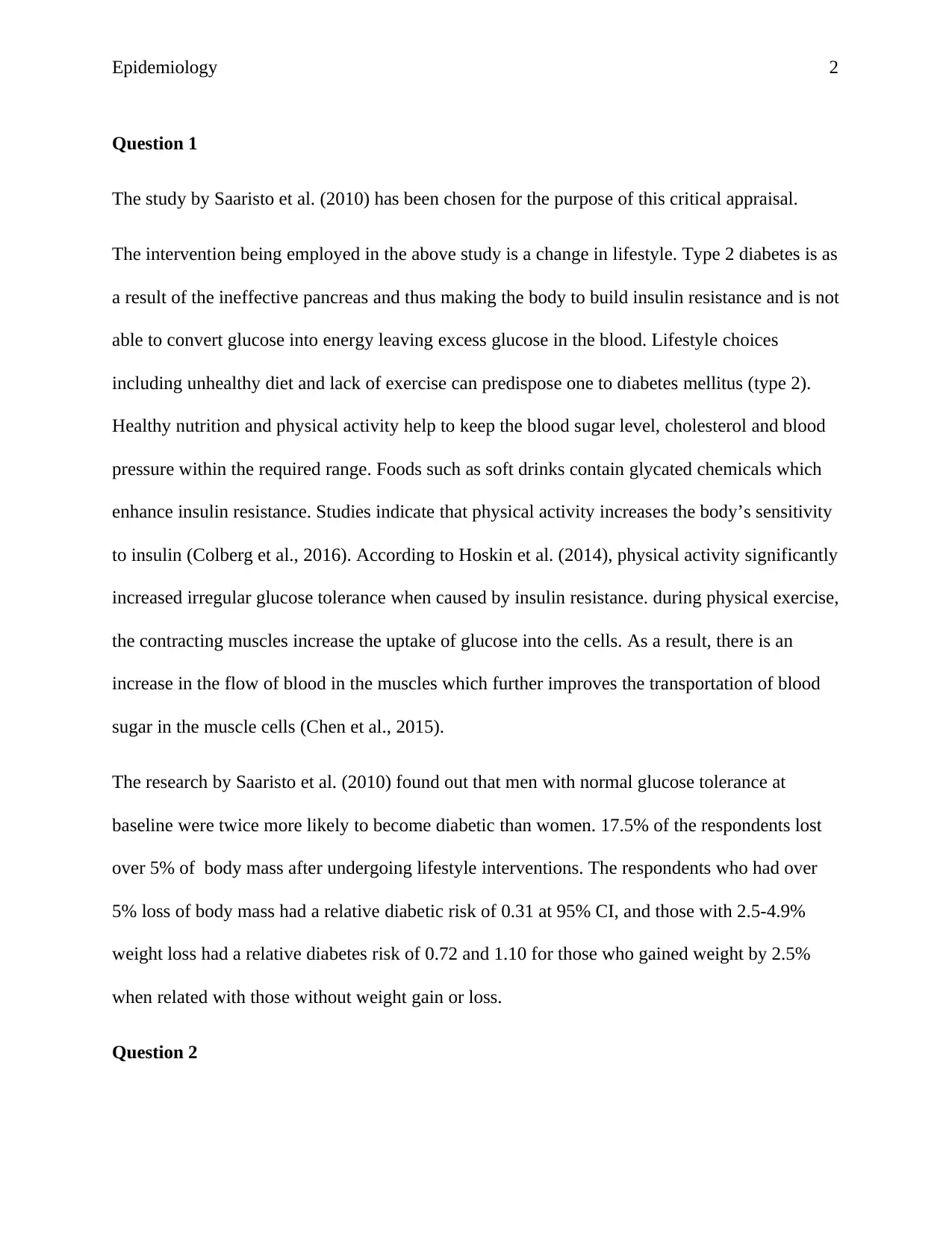
Epidemiology 2
Question 1
The study by Saaristo et al. (2010) has been chosen for the purpose of this critical appraisal.
The intervention being employed in the above study is a change in lifestyle. Type 2 diabetes is as
a result of the ineffective pancreas and thus making the body to build insulin resistance and is not
able to convert glucose into energy leaving excess glucose in the blood. Lifestyle choices
including unhealthy diet and lack of exercise can predispose one to diabetes mellitus (type 2).
Healthy nutrition and physical activity help to keep the blood sugar level, cholesterol and blood
pressure within the required range. Foods such as soft drinks contain glycated chemicals which
enhance insulin resistance. Studies indicate that physical activity increases the body’s sensitivity
to insulin (Colberg et al., 2016). According to Hoskin et al. (2014), physical activity significantly
increased irregular glucose tolerance when caused by insulin resistance. during physical exercise,
the contracting muscles increase the uptake of glucose into the cells. As a result, there is an
increase in the flow of blood in the muscles which further improves the transportation of blood
sugar in the muscle cells (Chen et al., 2015).
The research by Saaristo et al. (2010) found out that men with normal glucose tolerance at
baseline were twice more likely to become diabetic than women. 17.5% of the respondents lost
over 5% of body mass after undergoing lifestyle interventions. The respondents who had over
5% loss of body mass had a relative diabetic risk of 0.31 at 95% CI, and those with 2.5-4.9%
weight loss had a relative diabetes risk of 0.72 and 1.10 for those who gained weight by 2.5%
when related with those without weight gain or loss.
Question 2
Question 1
The study by Saaristo et al. (2010) has been chosen for the purpose of this critical appraisal.
The intervention being employed in the above study is a change in lifestyle. Type 2 diabetes is as
a result of the ineffective pancreas and thus making the body to build insulin resistance and is not
able to convert glucose into energy leaving excess glucose in the blood. Lifestyle choices
including unhealthy diet and lack of exercise can predispose one to diabetes mellitus (type 2).
Healthy nutrition and physical activity help to keep the blood sugar level, cholesterol and blood
pressure within the required range. Foods such as soft drinks contain glycated chemicals which
enhance insulin resistance. Studies indicate that physical activity increases the body’s sensitivity
to insulin (Colberg et al., 2016). According to Hoskin et al. (2014), physical activity significantly
increased irregular glucose tolerance when caused by insulin resistance. during physical exercise,
the contracting muscles increase the uptake of glucose into the cells. As a result, there is an
increase in the flow of blood in the muscles which further improves the transportation of blood
sugar in the muscle cells (Chen et al., 2015).
The research by Saaristo et al. (2010) found out that men with normal glucose tolerance at
baseline were twice more likely to become diabetic than women. 17.5% of the respondents lost
over 5% of body mass after undergoing lifestyle interventions. The respondents who had over
5% loss of body mass had a relative diabetic risk of 0.31 at 95% CI, and those with 2.5-4.9%
weight loss had a relative diabetes risk of 0.72 and 1.10 for those who gained weight by 2.5%
when related with those without weight gain or loss.
Question 2
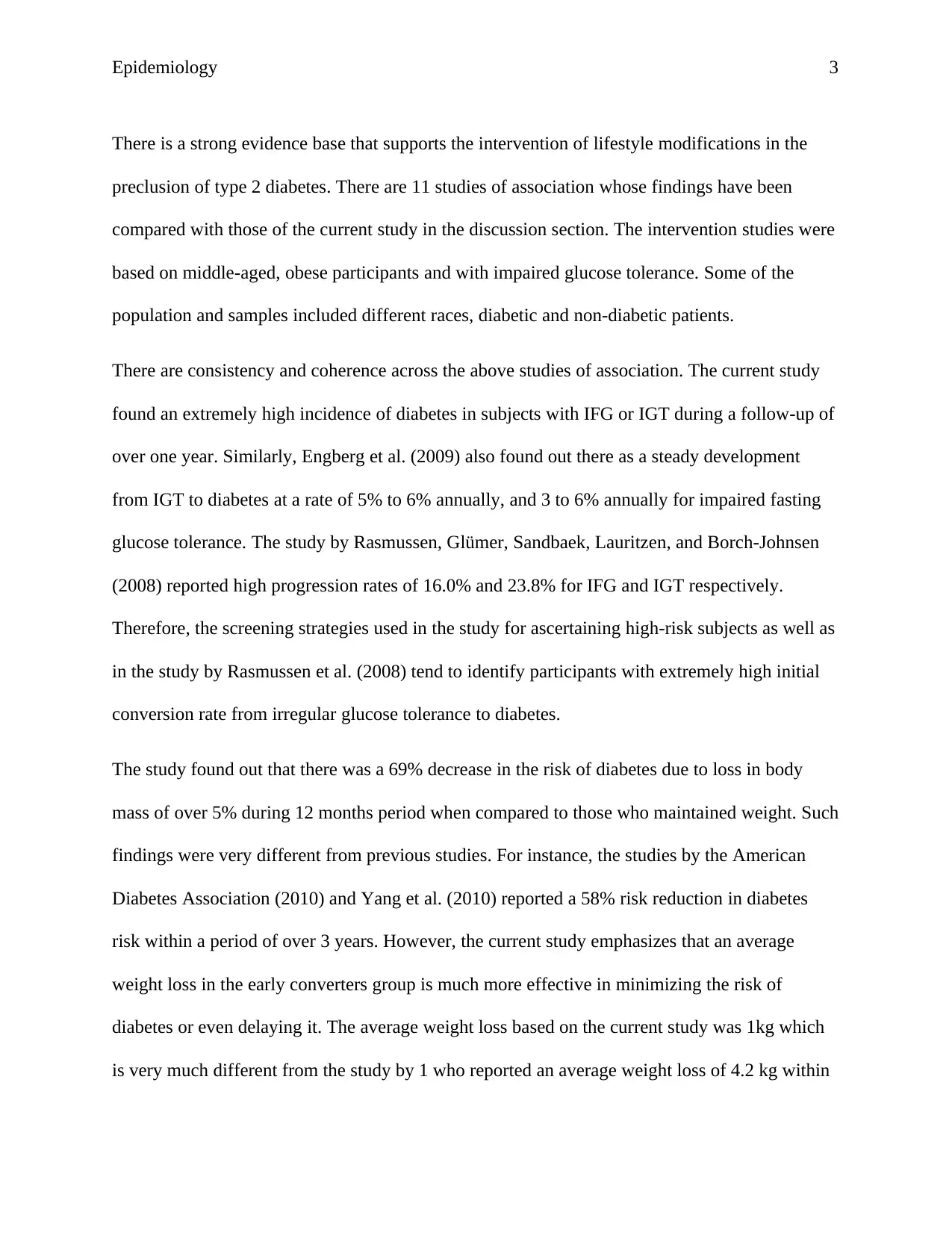
Epidemiology 3
There is a strong evidence base that supports the intervention of lifestyle modifications in the
preclusion of type 2 diabetes. There are 11 studies of association whose findings have been
compared with those of the current study in the discussion section. The intervention studies were
based on middle-aged, obese participants and with impaired glucose tolerance. Some of the
population and samples included different races, diabetic and non-diabetic patients.
There are consistency and coherence across the above studies of association. The current study
found an extremely high incidence of diabetes in subjects with IFG or IGT during a follow-up of
over one year. Similarly, Engberg et al. (2009) also found out there as a steady development
from IGT to diabetes at a rate of 5% to 6% annually, and 3 to 6% annually for impaired fasting
glucose tolerance. The study by Rasmussen, Glümer, Sandbaek, Lauritzen, and Borch-Johnsen
(2008) reported high progression rates of 16.0% and 23.8% for IFG and IGT respectively.
Therefore, the screening strategies used in the study for ascertaining high-risk subjects as well as
in the study by Rasmussen et al. (2008) tend to identify participants with extremely high initial
conversion rate from irregular glucose tolerance to diabetes.
The study found out that there was a 69% decrease in the risk of diabetes due to loss in body
mass of over 5% during 12 months period when compared to those who maintained weight. Such
findings were very different from previous studies. For instance, the studies by the American
Diabetes Association (2010) and Yang et al. (2010) reported a 58% risk reduction in diabetes
risk within a period of over 3 years. However, the current study emphasizes that an average
weight loss in the early converters group is much more effective in minimizing the risk of
diabetes or even delaying it. The average weight loss based on the current study was 1kg which
is very much different from the study by 1 who reported an average weight loss of 4.2 kg within
There is a strong evidence base that supports the intervention of lifestyle modifications in the
preclusion of type 2 diabetes. There are 11 studies of association whose findings have been
compared with those of the current study in the discussion section. The intervention studies were
based on middle-aged, obese participants and with impaired glucose tolerance. Some of the
population and samples included different races, diabetic and non-diabetic patients.
There are consistency and coherence across the above studies of association. The current study
found an extremely high incidence of diabetes in subjects with IFG or IGT during a follow-up of
over one year. Similarly, Engberg et al. (2009) also found out there as a steady development
from IGT to diabetes at a rate of 5% to 6% annually, and 3 to 6% annually for impaired fasting
glucose tolerance. The study by Rasmussen, Glümer, Sandbaek, Lauritzen, and Borch-Johnsen
(2008) reported high progression rates of 16.0% and 23.8% for IFG and IGT respectively.
Therefore, the screening strategies used in the study for ascertaining high-risk subjects as well as
in the study by Rasmussen et al. (2008) tend to identify participants with extremely high initial
conversion rate from irregular glucose tolerance to diabetes.
The study found out that there was a 69% decrease in the risk of diabetes due to loss in body
mass of over 5% during 12 months period when compared to those who maintained weight. Such
findings were very different from previous studies. For instance, the studies by the American
Diabetes Association (2010) and Yang et al. (2010) reported a 58% risk reduction in diabetes
risk within a period of over 3 years. However, the current study emphasizes that an average
weight loss in the early converters group is much more effective in minimizing the risk of
diabetes or even delaying it. The average weight loss based on the current study was 1kg which
is very much different from the study by 1 who reported an average weight loss of 4.2 kg within
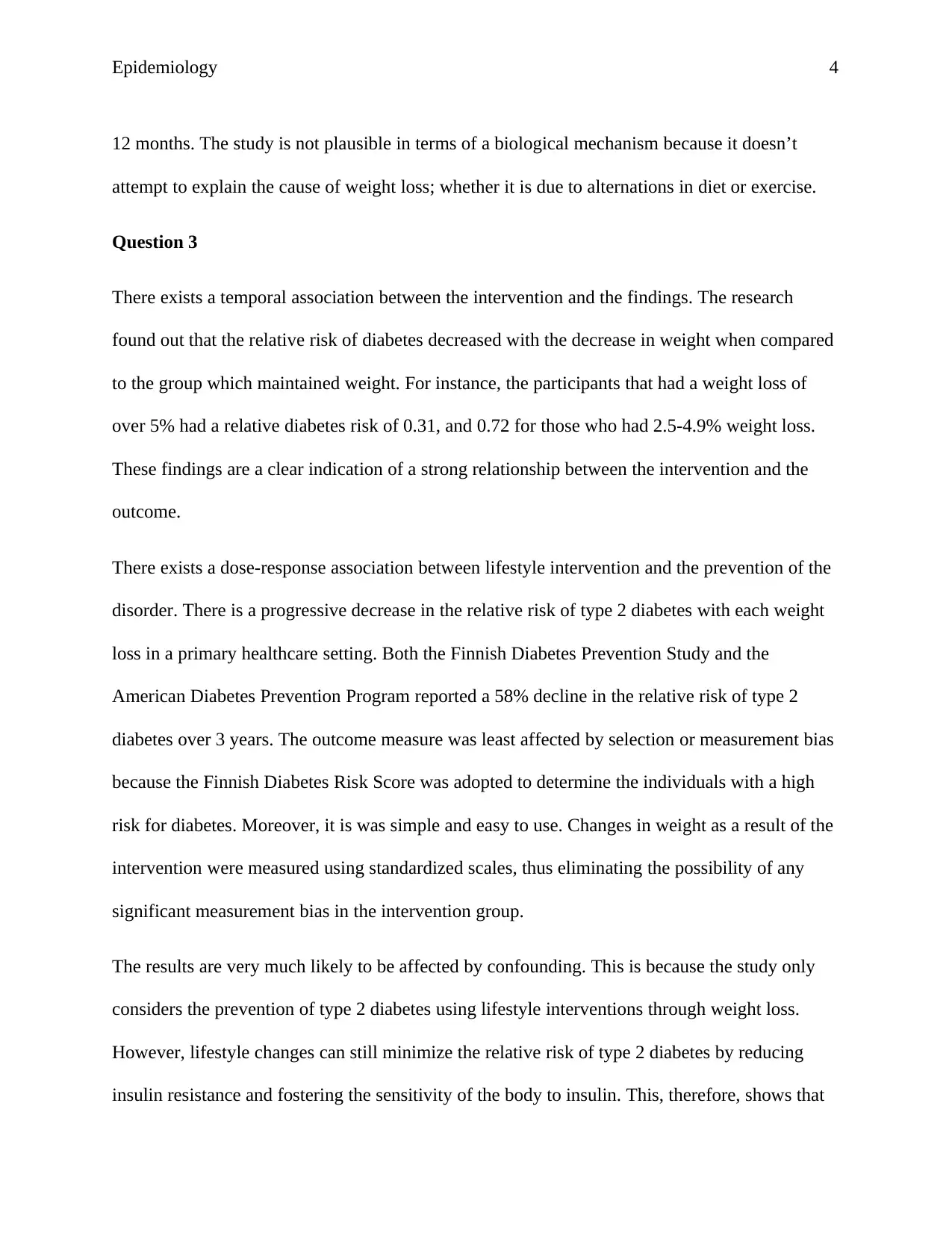
Epidemiology 4
12 months. The study is not plausible in terms of a biological mechanism because it doesn’t
attempt to explain the cause of weight loss; whether it is due to alternations in diet or exercise.
Question 3
There exists a temporal association between the intervention and the findings. The research
found out that the relative risk of diabetes decreased with the decrease in weight when compared
to the group which maintained weight. For instance, the participants that had a weight loss of
over 5% had a relative diabetes risk of 0.31, and 0.72 for those who had 2.5-4.9% weight loss.
These findings are a clear indication of a strong relationship between the intervention and the
outcome.
There exists a dose-response association between lifestyle intervention and the prevention of the
disorder. There is a progressive decrease in the relative risk of type 2 diabetes with each weight
loss in a primary healthcare setting. Both the Finnish Diabetes Prevention Study and the
American Diabetes Prevention Program reported a 58% decline in the relative risk of type 2
diabetes over 3 years. The outcome measure was least affected by selection or measurement bias
because the Finnish Diabetes Risk Score was adopted to determine the individuals with a high
risk for diabetes. Moreover, it is was simple and easy to use. Changes in weight as a result of the
intervention were measured using standardized scales, thus eliminating the possibility of any
significant measurement bias in the intervention group.
The results are very much likely to be affected by confounding. This is because the study only
considers the prevention of type 2 diabetes using lifestyle interventions through weight loss.
However, lifestyle changes can still minimize the relative risk of type 2 diabetes by reducing
insulin resistance and fostering the sensitivity of the body to insulin. This, therefore, shows that
12 months. The study is not plausible in terms of a biological mechanism because it doesn’t
attempt to explain the cause of weight loss; whether it is due to alternations in diet or exercise.
Question 3
There exists a temporal association between the intervention and the findings. The research
found out that the relative risk of diabetes decreased with the decrease in weight when compared
to the group which maintained weight. For instance, the participants that had a weight loss of
over 5% had a relative diabetes risk of 0.31, and 0.72 for those who had 2.5-4.9% weight loss.
These findings are a clear indication of a strong relationship between the intervention and the
outcome.
There exists a dose-response association between lifestyle intervention and the prevention of the
disorder. There is a progressive decrease in the relative risk of type 2 diabetes with each weight
loss in a primary healthcare setting. Both the Finnish Diabetes Prevention Study and the
American Diabetes Prevention Program reported a 58% decline in the relative risk of type 2
diabetes over 3 years. The outcome measure was least affected by selection or measurement bias
because the Finnish Diabetes Risk Score was adopted to determine the individuals with a high
risk for diabetes. Moreover, it is was simple and easy to use. Changes in weight as a result of the
intervention were measured using standardized scales, thus eliminating the possibility of any
significant measurement bias in the intervention group.
The results are very much likely to be affected by confounding. This is because the study only
considers the prevention of type 2 diabetes using lifestyle interventions through weight loss.
However, lifestyle changes can still minimize the relative risk of type 2 diabetes by reducing
insulin resistance and fostering the sensitivity of the body to insulin. This, therefore, shows that
Secure Best Marks with AI Grader
Need help grading? Try our AI Grader for instant feedback on your assignments.
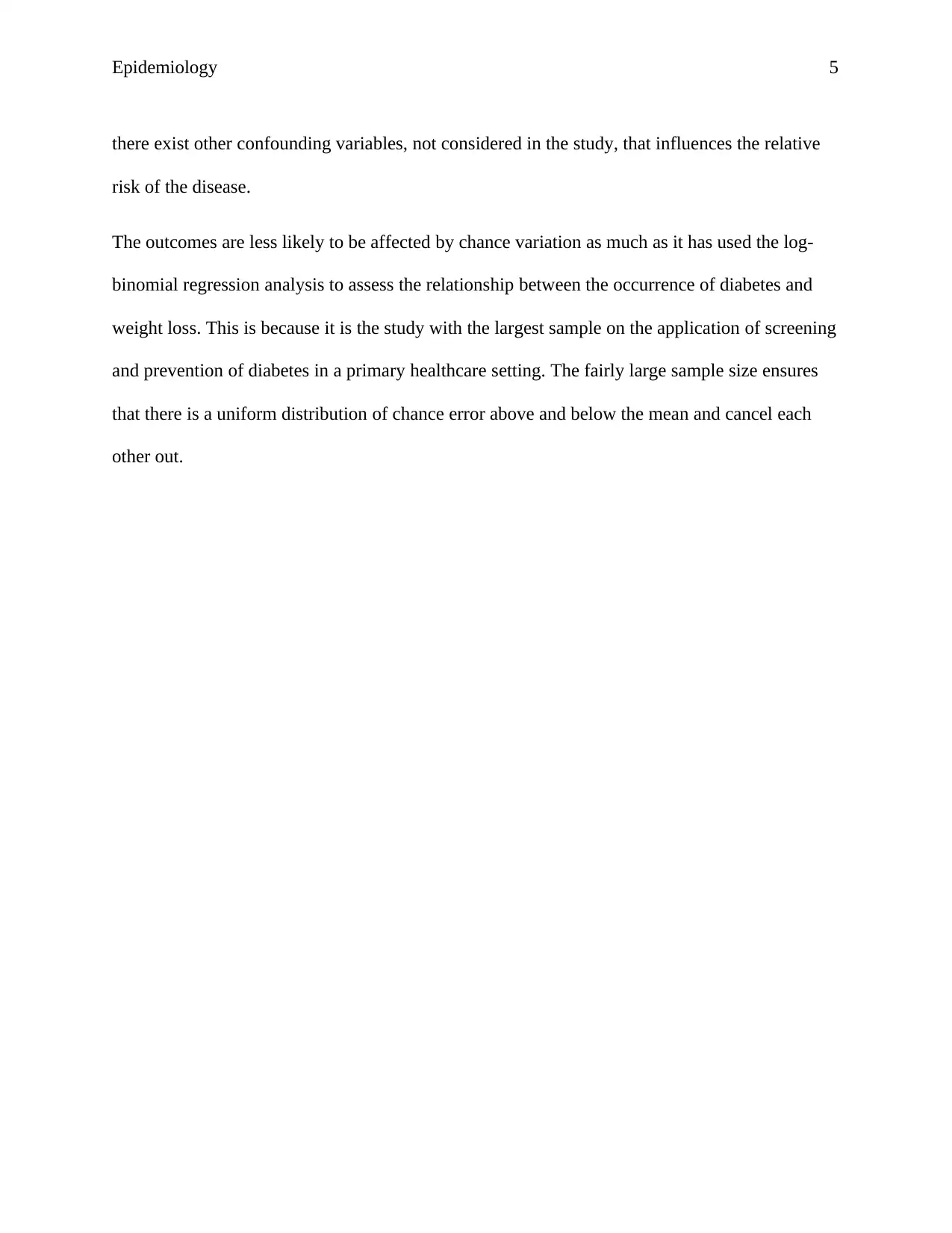
Epidemiology 5
there exist other confounding variables, not considered in the study, that influences the relative
risk of the disease.
The outcomes are less likely to be affected by chance variation as much as it has used the log-
binomial regression analysis to assess the relationship between the occurrence of diabetes and
weight loss. This is because it is the study with the largest sample on the application of screening
and prevention of diabetes in a primary healthcare setting. The fairly large sample size ensures
that there is a uniform distribution of chance error above and below the mean and cancel each
other out.
there exist other confounding variables, not considered in the study, that influences the relative
risk of the disease.
The outcomes are less likely to be affected by chance variation as much as it has used the log-
binomial regression analysis to assess the relationship between the occurrence of diabetes and
weight loss. This is because it is the study with the largest sample on the application of screening
and prevention of diabetes in a primary healthcare setting. The fairly large sample size ensures
that there is a uniform distribution of chance error above and below the mean and cancel each
other out.
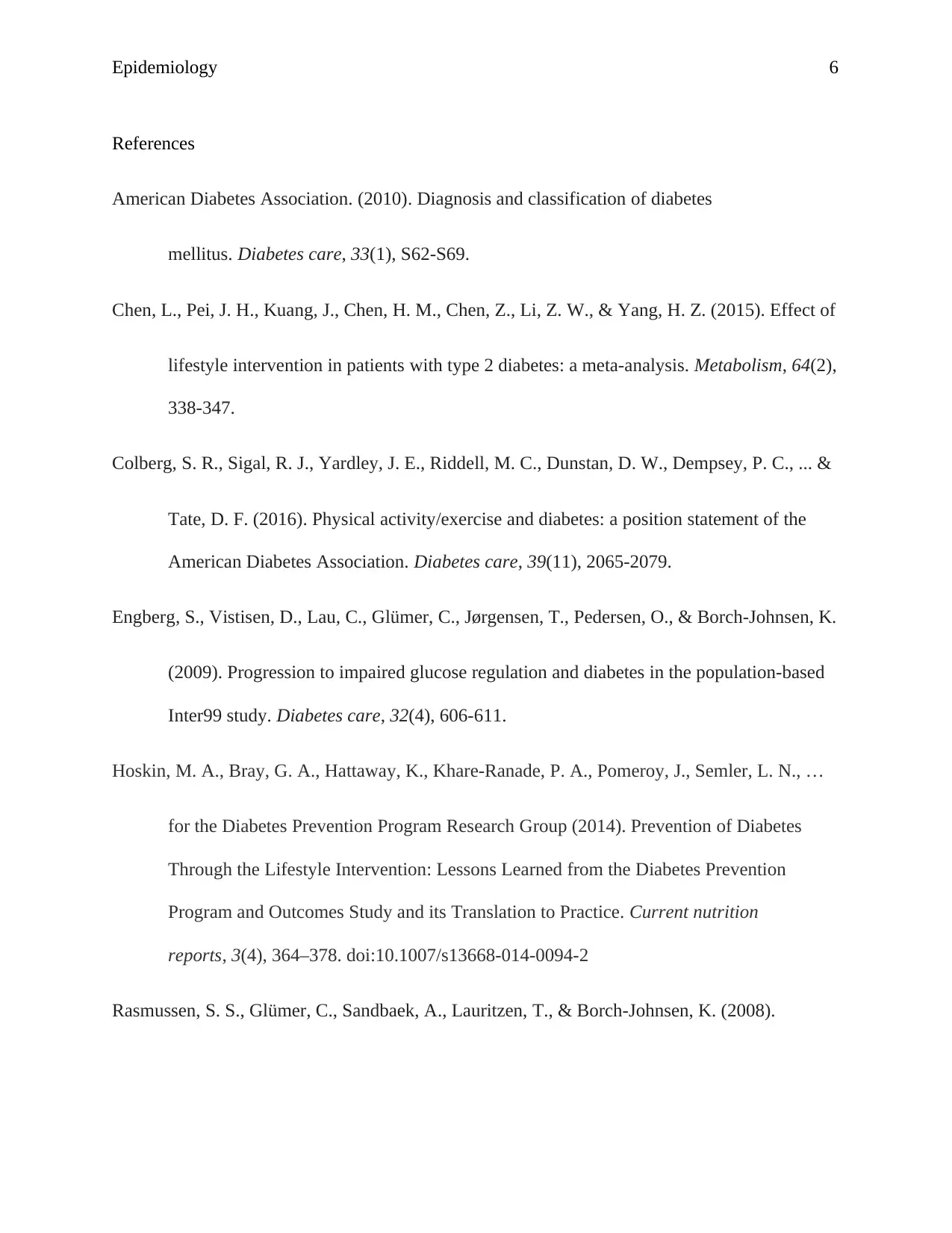
Epidemiology 6
References
American Diabetes Association. (2010). Diagnosis and classification of diabetes
mellitus. Diabetes care, 33(1), S62-S69.
Chen, L., Pei, J. H., Kuang, J., Chen, H. M., Chen, Z., Li, Z. W., & Yang, H. Z. (2015). Effect of
lifestyle intervention in patients with type 2 diabetes: a meta-analysis. Metabolism, 64(2),
338-347.
Colberg, S. R., Sigal, R. J., Yardley, J. E., Riddell, M. C., Dunstan, D. W., Dempsey, P. C., ... &
Tate, D. F. (2016). Physical activity/exercise and diabetes: a position statement of the
American Diabetes Association. Diabetes care, 39(11), 2065-2079.
Engberg, S., Vistisen, D., Lau, C., Glümer, C., Jørgensen, T., Pedersen, O., & Borch-Johnsen, K.
(2009). Progression to impaired glucose regulation and diabetes in the population-based
Inter99 study. Diabetes care, 32(4), 606-611.
Hoskin, M. A., Bray, G. A., Hattaway, K., Khare-Ranade, P. A., Pomeroy, J., Semler, L. N., …
for the Diabetes Prevention Program Research Group (2014). Prevention of Diabetes
Through the Lifestyle Intervention: Lessons Learned from the Diabetes Prevention
Program and Outcomes Study and its Translation to Practice. Current nutrition
reports, 3(4), 364–378. doi:10.1007/s13668-014-0094-2
Rasmussen, S. S., Glümer, C., Sandbaek, A., Lauritzen, T., & Borch-Johnsen, K. (2008).
References
American Diabetes Association. (2010). Diagnosis and classification of diabetes
mellitus. Diabetes care, 33(1), S62-S69.
Chen, L., Pei, J. H., Kuang, J., Chen, H. M., Chen, Z., Li, Z. W., & Yang, H. Z. (2015). Effect of
lifestyle intervention in patients with type 2 diabetes: a meta-analysis. Metabolism, 64(2),
338-347.
Colberg, S. R., Sigal, R. J., Yardley, J. E., Riddell, M. C., Dunstan, D. W., Dempsey, P. C., ... &
Tate, D. F. (2016). Physical activity/exercise and diabetes: a position statement of the
American Diabetes Association. Diabetes care, 39(11), 2065-2079.
Engberg, S., Vistisen, D., Lau, C., Glümer, C., Jørgensen, T., Pedersen, O., & Borch-Johnsen, K.
(2009). Progression to impaired glucose regulation and diabetes in the population-based
Inter99 study. Diabetes care, 32(4), 606-611.
Hoskin, M. A., Bray, G. A., Hattaway, K., Khare-Ranade, P. A., Pomeroy, J., Semler, L. N., …
for the Diabetes Prevention Program Research Group (2014). Prevention of Diabetes
Through the Lifestyle Intervention: Lessons Learned from the Diabetes Prevention
Program and Outcomes Study and its Translation to Practice. Current nutrition
reports, 3(4), 364–378. doi:10.1007/s13668-014-0094-2
Rasmussen, S. S., Glümer, C., Sandbaek, A., Lauritzen, T., & Borch-Johnsen, K. (2008).
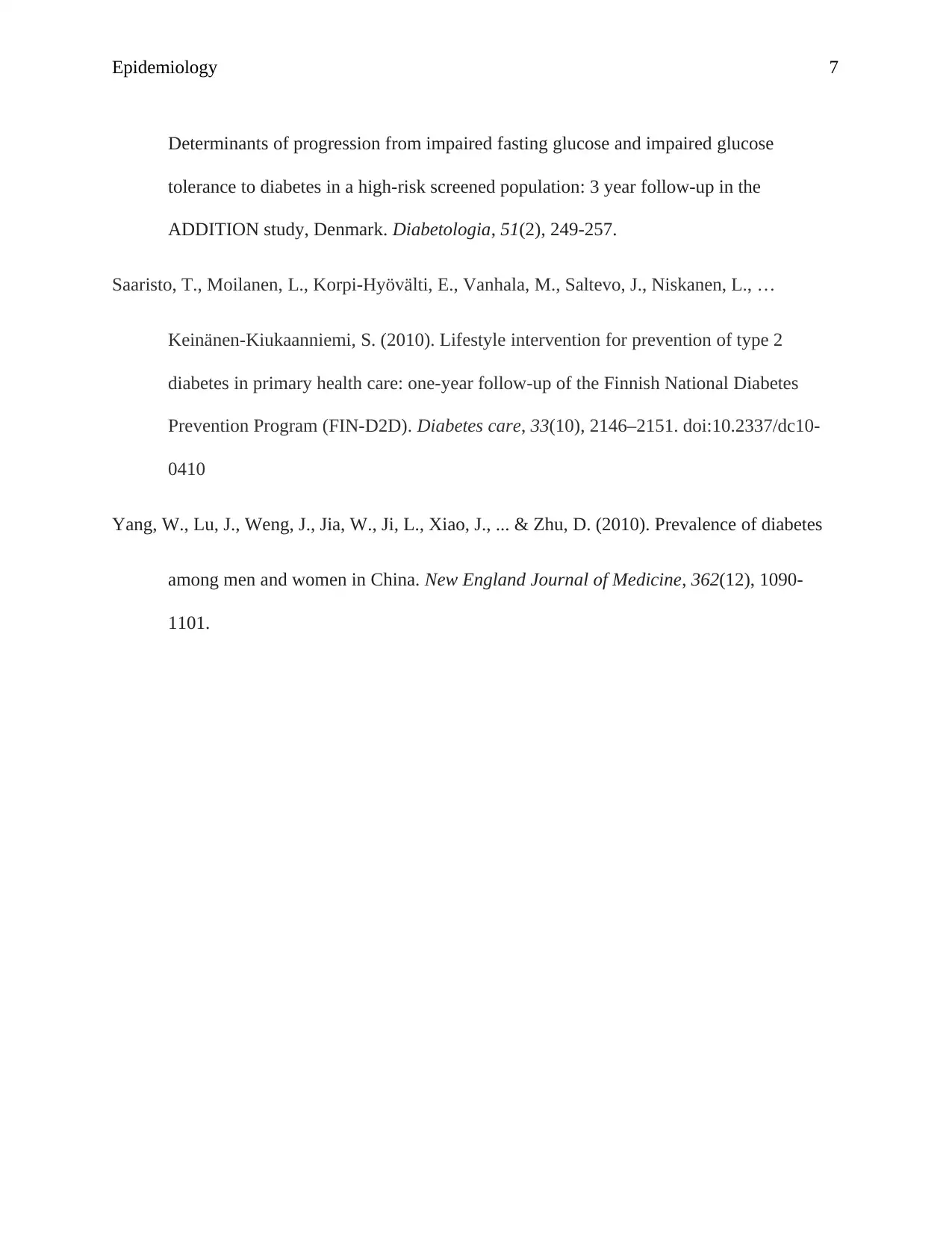
Epidemiology 7
Determinants of progression from impaired fasting glucose and impaired glucose
tolerance to diabetes in a high-risk screened population: 3 year follow-up in the
ADDITION study, Denmark. Diabetologia, 51(2), 249-257.
Saaristo, T., Moilanen, L., Korpi-Hyövälti, E., Vanhala, M., Saltevo, J., Niskanen, L., …
Keinänen-Kiukaanniemi, S. (2010). Lifestyle intervention for prevention of type 2
diabetes in primary health care: one-year follow-up of the Finnish National Diabetes
Prevention Program (FIN-D2D). Diabetes care, 33(10), 2146–2151. doi:10.2337/dc10-
0410
Yang, W., Lu, J., Weng, J., Jia, W., Ji, L., Xiao, J., ... & Zhu, D. (2010). Prevalence of diabetes
among men and women in China. New England Journal of Medicine, 362(12), 1090-
1101.
Determinants of progression from impaired fasting glucose and impaired glucose
tolerance to diabetes in a high-risk screened population: 3 year follow-up in the
ADDITION study, Denmark. Diabetologia, 51(2), 249-257.
Saaristo, T., Moilanen, L., Korpi-Hyövälti, E., Vanhala, M., Saltevo, J., Niskanen, L., …
Keinänen-Kiukaanniemi, S. (2010). Lifestyle intervention for prevention of type 2
diabetes in primary health care: one-year follow-up of the Finnish National Diabetes
Prevention Program (FIN-D2D). Diabetes care, 33(10), 2146–2151. doi:10.2337/dc10-
0410
Yang, W., Lu, J., Weng, J., Jia, W., Ji, L., Xiao, J., ... & Zhu, D. (2010). Prevalence of diabetes
among men and women in China. New England Journal of Medicine, 362(12), 1090-
1101.
1 out of 7
Related Documents
Your All-in-One AI-Powered Toolkit for Academic Success.
+13062052269
info@desklib.com
Available 24*7 on WhatsApp / Email
![[object Object]](/_next/static/media/star-bottom.7253800d.svg)
Unlock your academic potential
© 2024 | Zucol Services PVT LTD | All rights reserved.





